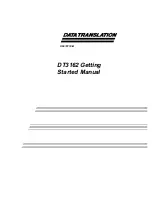
7
Configuring the Equivalent Loads (Resistor Packs)
As shipped, there are two resistor packs installed in sockets RN1-RN2 for the 64487/
64488 cards. With the 65488, there are four packs installed in RN1-RN4. The 61488 card
has sockets labeled J2 and J3 for the resistor packs. These provide 10 additional
equivalent loads, as defined in the IEEE 488.1-1987 standard. For systems with few
devices and long cable lengths, the additional loads are required to provide increased
signal integrity and better transfer rates on the cable. In most situations, they can be left
installed, which gives a total of 11 loads for the card.
However, there is a maximum of 20 equivalent loads per bus system. Most devices have
one equivalent load, so a maximum of nine additional devices can be used while the
resistors are installed. If your bus system will have more than nine additional devices,
carefully remove both of the resistor packs and store them.
If the resistors need to be reinstalled later on, be sure that the visual key aligns with pin 1
on the sockets. Pin 1 is denoted with either the number “1”, or a circle. The resistor
packs are equivalent, and can be interchanged.
J2 and J3 are a pair, RN1 and RN2 are a pair, and RN3 and RN4 are a pair, and pairs must
be installed together.
For full details on the constraints in configuring a bus system, refer to section 5.2.3 in the
IEEE 488.1-1987 specification. The TAMS cards are capable of operation at 1 Mbyte per
second, and therefore the constraints in that section apply. This requires 48 mA tri-state
drivers be used in all devices, all devices must be powered on, and cabling must be a
maximum of 15 meters total length with at least one equivalent load per meter of cabling.
The 65488 provides two separate GPIB busses, so 15 meters of cabling can be attached
to each bus.








































